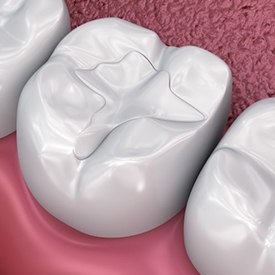Tooth-Colored Fillings – Mesquite, TX
Fill Your Cavities Seamlessly and Beautifully

When the dentist tells you that you have a cavity, it used to mean you’d have to get a mouth full of metal to fill it up. Fortunately, modern dentistry has come a long way, so fillings these days are made of a composite resin material that can be color-matched to seamlessly and beautifully blend in with the rest of your tooth. They perfectly mimic the structure of natural teeth, even down to the way they reflect light. The next time Dr. McKnight says you have a cavity, you can rest easy knowing that your filling will be virtually unnoticeable.
What Are Tooth-Colored Fillings Made Of?

Tooth-colored fillings are most commonly made of composite resin. For this material, a fluid matrix of an acrylic is hardened around glass filler particles using a special curing light. Trace amounts of metals like gold, copper, and cobalt are added to give the glass its color. Elements such as titanium and zirconium add opacity. These materials work together to make each filling customized to fit your tooth.
Benefits of Tooth-Colored Fillings vs. Amalgam Fillings

The most obvious advantage of tooth-colored fillings over traditional metal, or amalgam, fillings is that tooth-colored ones can be color-matched to blend in with your teeth. For this reason, they’re often referred to as “white fillings.”
However, tooth-colored fillings also have a few other benefits over their metal counterparts. They can be hardened in just seconds using a curing light, whereas amalgam fillings may take a few hours to completely harden. They are also a more conservative approach than amalgam. With metal fillings, the dentist would have to remove some of the natural tooth structure to make room. Tooth-colored fillings can be applied seamlessly to the outside of the tooth without compromising any of its structure.
How Are Tooth-Colored Fillings Placed?

Tooth-colored fillings are chemically bonded to the teeth. Sometimes Dr. McKnight might not even administer a local anesthetic, especially if the cavity only penetrates the enamel, or the white outer shell of the tooth. If decay has reached the sensitive dentin layer underneath, then the tooth will be numbed. Once the decayed material has been removed, the composite resin is applied to the tooth. When it’s in the correct shape, the resin is hardened with the curing light. During this process, Dr. McKnight will check your bite to make sure your teeth fit together properly.
Caring for Your Tooth-Colored Fillings
Your composite fillings can last up to fifteen years with excellent care. That entails following good oral hygiene practices. Brush your teeth twice a day with fluoride toothpaste to strengthen your teeth. Floss once a day to keep decay from forming between your teeth and along your gumline. Limit sugary snacks and drinks. Most importantly, see Dr. McKnight for a checkup every six months to make sure your filling is in good condition.
More to Explore
Preventive Dentistry Cosmetic Dentistry Advanced Technology View Our Services
